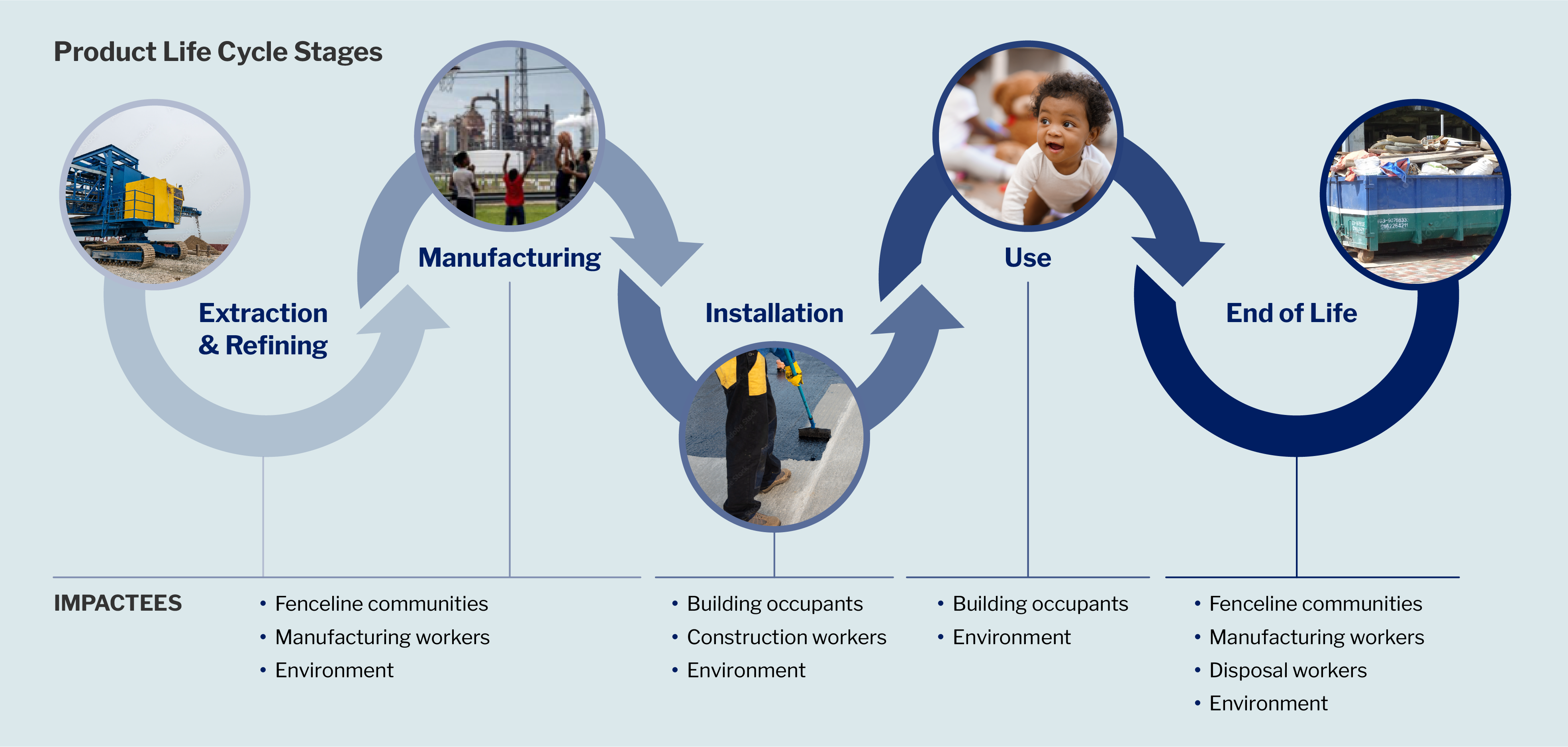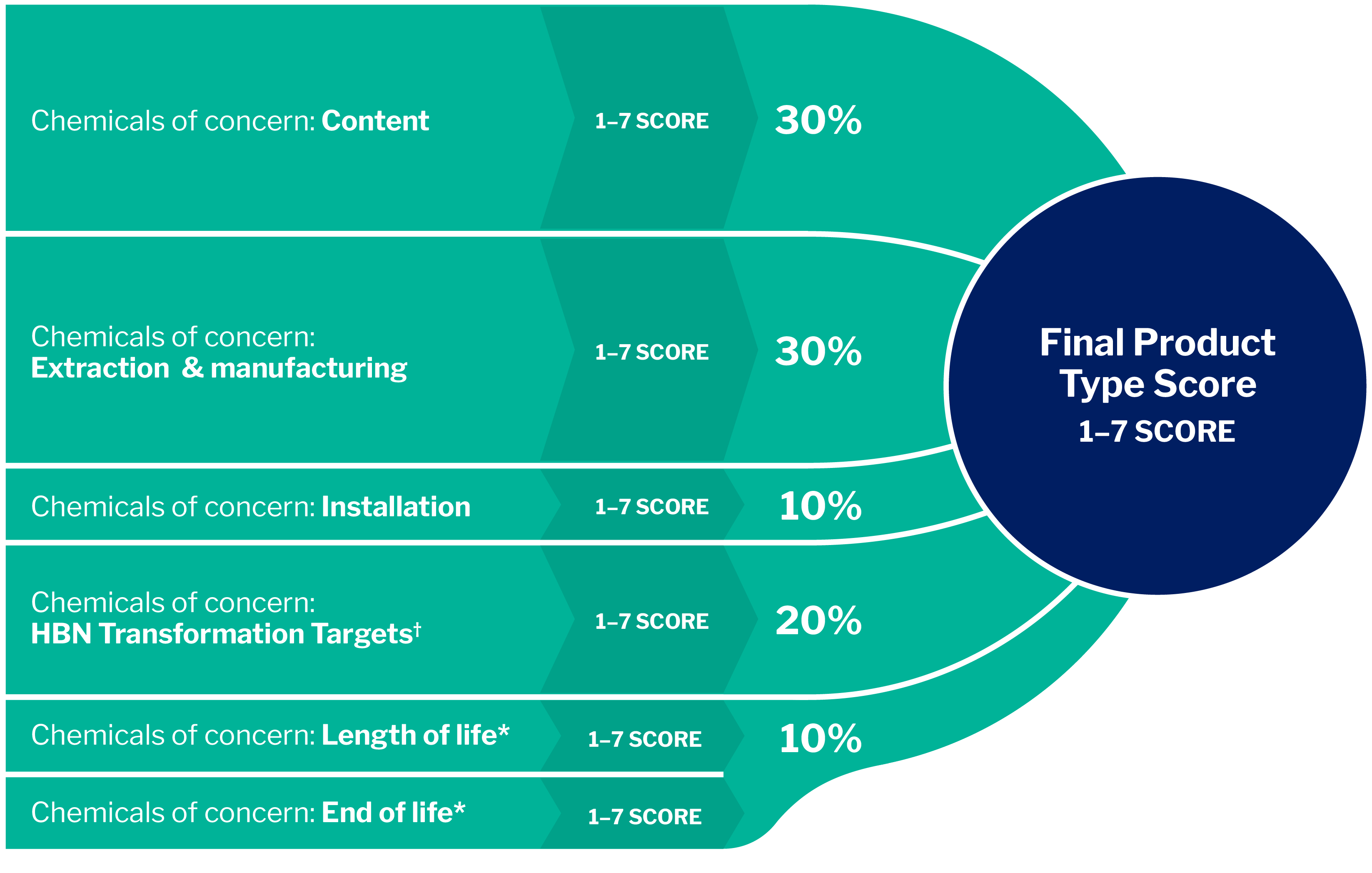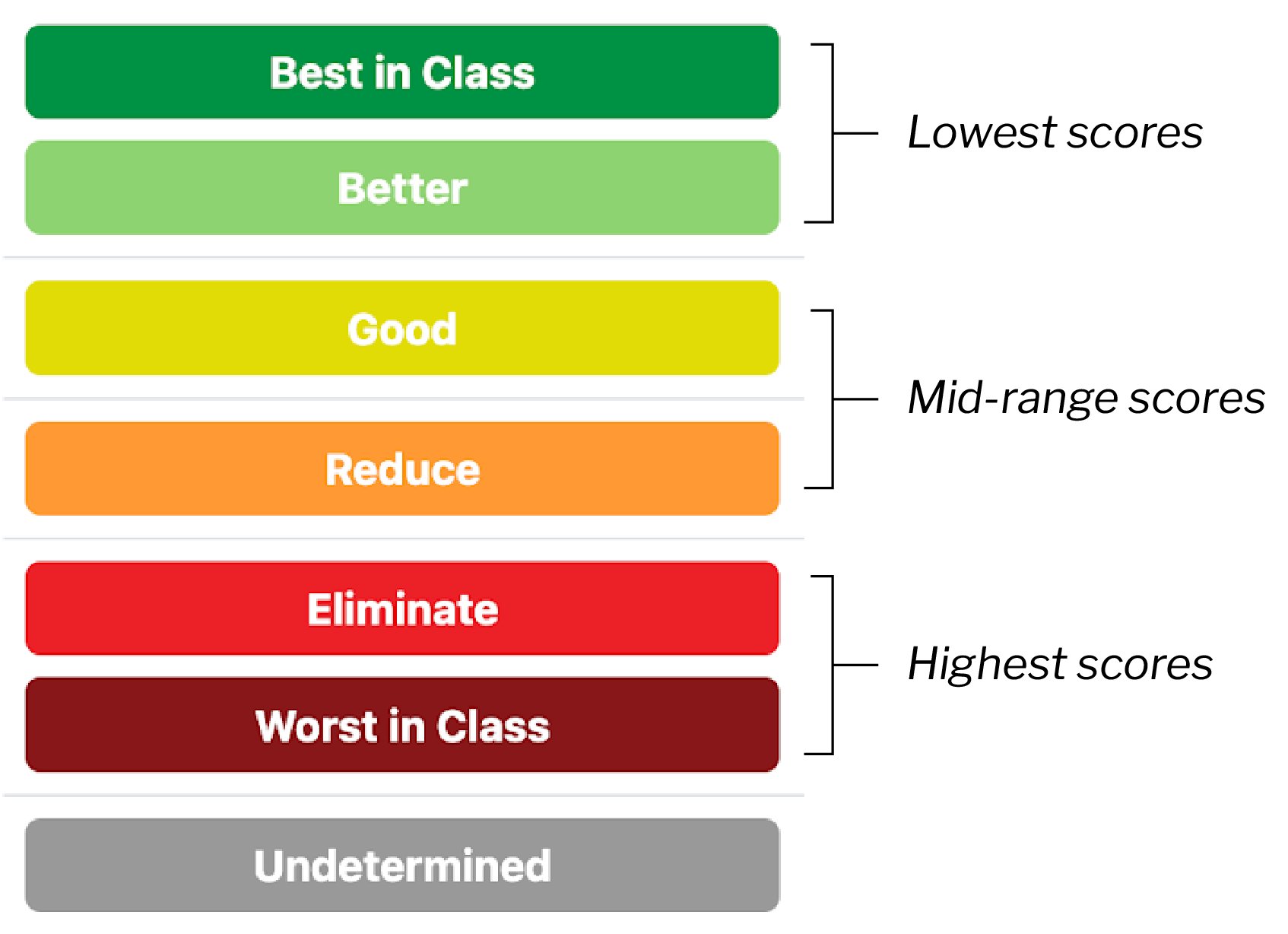Informed™ Methodology
Informed™ helps project teams quickly and easily choose safer Product Types using a simple red-to-green product ranking.
Informed is built upon Habitable’s 20+ years of comprehensive research into building materials and their associated hazards. Based on analysis of six evaluation criteria, Informed visualizes the potential health impacts of different building products on people (including workers, fenceline communities, and building occupants) and the environment throughout the product life cycle.
Informed takes into account hazardous chemicals at all life cycle stages. It also considers human health and environmental impacts on different communities along the way.
- Evaluation Criteria
- 1 Content
- 2 Extraction & manufacturing
- 3 Installation
- 4 Habitable’s Transformation Targets
- 5 Length of life
- 6 End of life

How are the color rankings developed?
STEP 1: Define Product Categories and Product Types to compare
Product Categories correspond whenever possible with CSI MasterFormat® divisions or sections. Product Categories group products based on their shared general function within a building, such as flooring (division 09 60 00) or insulation (section 07 21 00).
Product Types correspond whenever possible with CSI MasterFormat® sections. Product Types are variations in form or formulation within a Product Category.

For example, the flooring category includes Product Types such as linoleum, vinyl sheet, and tile carpeting; the insulation category includes Product Types such as extruded polystyrene board (XPS), fiberglass batt, and spray polyurethane foam.

To date, Informed is optimized for use in North America, with an emphasis on frequently used Product Types.
STEP 2: Create Common Product profiles
Using a standardized research process called the Common Product methodology, a Common Product profile (CP) is generated for each Product Type. The profile includes a list of the chemicals most commonly used in this Product Type along with the function and percent weight in the overall product. Though specific manufacturer products may deviate from the content determined to be "common" in a Product Type, our approach represents what a buyer or consumer would typically encounter in a given Product Type according to market research.
STEP 3: Compare Product Types within their respective category
Different Product Types within a Product Category are assessed and compared based on the chemical hazards across their life cycles. The criteria used for this comparison are outlined below. For each of the criteria, we assign a 1-7 score (using sub-criteria when applicable) to differentiate between the Product Types in that category. Generally speaking, a Product Type with no identified or the least identified health impacts is assigned a score of 1. The Product Type with the worst impacts is assigned a score of 7. The rest of the Product Types are grouped based on natural breaks, where those with similar impacts are grouped together. Expert judgment is included in defining the relative weighting of sub-criteria and criteria.
Evaluation Criteria
The following criteria are considered for comparing Product Types in Informed. Not all criteria are applicable for all categories.
| 1 = | No chemicals of concern |
| 7 = | Large amounts of chemicals of concern |
When hazardous chemicals are used in products, exposures can occur at any life cycle stage. Considering hazardous common content accounts for potential exposures during chemical and product manufacturing, installation, use, and end of life.
| 1 = | None known |
| 7 = | Largest quantities of petrochemicals and base material with worst hazardous chemical impacts |
Often, the most significant chemical impacts of a product occur during raw material extraction and product manufacturing. These impacts have important environmental justice implications because fenceline communities living near extraction and manufacturing are disproportionately BIPOC and/or low-income communities.
| 1 = | No exposure concerns from product or accessory installation products |
| 7 = | Volatile hazardous chemicals reacted on site |
Workers who install products may be exposed to different chemicals than building occupants or may see greater exposures over time when working with hazardous products on a daily basis. This can lead to greater impacts on their health.
| 1 = | No Transformation Targets |
| 7 = | Transformation Targets in common content |
Habitable’s Transformation Targets have been identified as the most impactful and avoidable Product Category and chemical combinations. More information and a list of these targets are available in our Transformation Targets guide.
| 1 = | Life expectancy is length of building life |
| 7 = | Life expectancy of 5-10 years |
Longer lived products reduce the frequency with which new products must be produced and installed, thereby avoiding the related impacts. Longer lived products also reduce the frequency of any end of life impacts.
| 1 = | Product is most often recycled into products of equal or higher value |
| 7 = | Product is disposed (e.g. landfilled or burned) |
Products that are disposed of at their end of life typically end up in landfills or are incinerated. Landfilled products can release toxic chemicals into the environment, and burning can generate additional hazardous releases that impact fenceline communities. If products are not landfilled or burned but instead reused or recycled into similar or higher value products, that reduces the end of life impacts and reduces the frequency of virgin product creation. Emphasis is on what is done in practice.
Scoring a Product Type
A weighting factor is then applied to each criteria to calculate one final Product Type score. This provides the starting point for ranking a group of Product Types in a category color ranking used in Informed.

† If there are no Transformation Targets in the category, and no differentiation among product types regarding the length of life and end of life criteria, the weighting is split equally between the three remaining criteria.
* If neither criteria is included in the scoring, this weighting is added to one or more of the other criteria based on category specific reasoning.

Why 1-7 Scoring?
A 1-7 scoring system applied at each level provides a manageable number of groupings to identify distinguishing features, without being overly complex. This adequately creates a continuum of improvement within each criterion and the overall color ranking system.
STEP 4: Assign color rankings
Once a final score is assigned to each Product Type, all Product Types that have been assessed in a Product Category are compared.
Each Product Type is then assigned a color reflective of its comparative score. Those with the lowest (or best) scores are classified as green in the color ranking system and those with the highest (or worst) scores are classified as red.
The colors reflect the relative ranking within the category. A green in one category will not be equivalent to a green in another category, but will reflect one of the best options available in that category at the time of our research to help minimize human and environmental health impacts.
In addition, not all CSI Divisions and Titles are currently depicted in our guidance. Gray means that the Product Type has not been evaluated yet, so no color ranking can be assigned.


Highlighting Chemical Hazard Differences within Product Types
There are situations when multiple colors are assigned for a single Product Type. This occurs:
- when a formulation that is significantly better than the common one within a Product Type is available;
- if formulations with significantly different chemical hazards are both relatively common; or
- if distinguishing a worse than common formulation is necessary in order to provide context.
For instance, the most commonly used binder in mineral wool batts (blanket) and board insulation is formaldehyde-based, but there are products available on the market that use safer binders. Because of this significant differentiation, standard mineral wool insulation (that contains formaldehyde) is given a different color ranking from formaldehyde-free mineral wool insulation. The full analysis and scoring outlined above is completed for each variation.
Who and What are Considered?
Building products impact people and the environment at every stage of their life cycle. Informed is the first simplified tool to use these human health and environmental impacts to rank Product Types.
| CRITERIA | Chemicals of Concern: Content |
Chemicals of Concern: Extraction & manufacturing |
Chemicals of Concern: Installation |
Chemicals of Concern: Habitable’s Transformation Targets |
Chemicals of Concern: Length of life |
Chemicals of Concern: End of life |
|---|---|---|---|---|---|---|
| Life Cycle Phase | ||||||
| Extraction/Refinement | Not considered | Considered | Not considered | Not considered | Considered | Considered |
| Manufacturing | Considered | Considered | Not considered | Considered | Considered | Considered |
| Installation | Considered | Not considered | Considered | Considered | Considered | Not considered |
| Use | Considered | Not considered | Not considered | Considered | Not considered | Not considered |
| End of life | Considered | Not considered | Not considered | Considered | Considered | Considered |
| Impactee | ||||||
| Building occupants | Considered | Not considered | Considered | Considered | Not considered | Not considered |
| Fenceline communities | Considered | Considered | Not considered | Considered | Considered | Considered |
| Manufacturing workers | Considered | Considered | Not considered | Considered | Considered | Considered |
| Construction workers | Considered | Not considered | Considered | Considered | Considered | Not considered |
| Disposal workers | Considered | Not considered | Not considered | Considered | Considered | Considered |
| Environment | Considered | Considered | Considered | Considered | Considered | Considered |
What are the limitations of the color rankings?
The goal of Informed is to translate complex chemical content and life cycle chemical hazard information into simple, actionable recommendations based on the safest options available within a Product Category. Informed is backed by extensive research and data but is not an exhaustive analysis. In general, Informed is a screening-level tool that captures the biggest concerns based on publicly available information.
How do we keep these rankings updated?
The red to green guidance will be updated as we gain new understanding of product content, chemical hazards, chemical impacts at various life cycle stages, and the Product Types available within each Product Category. Product guidance for a particular Product Category is always dated to indicate when the most recent version was last updated. We also continue to update and evolve our process as needed.
Date updated: April 17, 2023